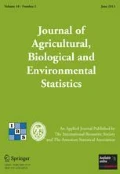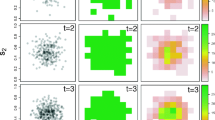Abstract
Few species are likely to be so evident that they will always be detected at a site when present. Recently a model has been developed that enables estimation of the proportion of area occupied, when the target species is not detected with certainty. Here we apply this modeling approach to data collected on terrestrial salamanders in the Plethodon glutinosus complex in the Great Smoky Mountains National Park, USA, and wish to address the question “how accurately does the fitted model represent the data?” The goodness-of-fit of the model needs to be assessed in order to make accurate inferences. This article presents a method where a simple Pearson chi-square statistic is calculated and a parametric bootstrap procedure is used to determine whether the observed statistic is unusually large. We found evidence that the most global model considered provides a poor fit to the data, hence estimated an overdispersion factor to adjust model selection procedures and inflate standard errors. Two hypothetical datasets with known assumption violations are also analyzed, illustrating that the method may be used to guide researchers to making appropriate inferences. The results of a simulation study are presented to provide a broader view of the methods properties.
Similar content being viewed by others
References
Azuma, D. L., Baldwin, J. A., and Noon, B. R. (1990), “Estimating the Occupancy of Spotted Owl Habitat Areas by Sampling and Adjusting Bias,” USDA Forest Service General technical Report, PSW-124.
Bailey, L. L., Simons, T. R., and Pollock, K. H. (2004), “Estimating Site Occupancy and Species Detection Probability Parameters for Terrestrial Salamanders,” Ecological Applications, 14, 692–702.
Bayley, P. B., and Peterson, J. T. (2001), “An Approach to Estimate Probability of Presence and Richness of Fish Species,” Transactions of the American Fisheries Society, 130, 620–633.
Boyce, M. S., and McDonald, L. L. (1999), “Relating Populations to Habitats Using Resource Selection Functions,” Trends in Ecology and Evolution, 14, 268–272.
Burnham, K. P., and Anderson, D. R. (1998), Model Selection and Inference, New York: Springer-Verlag.
Cox, D. R., and Snell, E. J. (1989), Analysis of Binary Data (2nd ed.), New York: Chapman and Hall.
Diamond, J. M. (1975), “Assembly of Species Communities,” in Ecology and Evolution of Communities, eds. M. L. Cody and J. M. Diamond, Cambridge, MA: Harvard University Press, pp. 342–444.
Geissler, P. H., and Fuller, M. R. (1987), “Estimation of the Proportion of area Occupied by an Animal Species,” in Proceedings of the Section on Survey Research Methods of the American Statistical Association, Alexandria, VA: American Statistical Association, pp. 533–538.
Hanski, I. (1992), “Inferences From Ecological Incidence Functions,” American Naturalist, 139, 657–662.
— (1994), “A Practical Model of Metapopulation Dynamics,” Journal of Animal Ecology, 63, 151–162.
— (1997), “Metapopulation Dynamics: From Concepts and Observations to Predictive Models,” in Metapopulation Biology: Ecology, Genetics, and Evolution, eds. I. A. Hanski and M. E. Gilpin, New York: Academic Press, pp. 69–91.
Hosmer, D. W., and Lemeshow, S. (1989), Applied Logistic Regression, New York: Wiley.
Hyde, E. J., and Simons, T. R. (2001), “Sampling Plethodontid Salamanders: Sources of Variability,” Journal of Wildlife Management, 65, 624–632.
Lebreton, J. D., Burnham, K. P., Clobert, J., and Anderson, D. R. (1992), “Modeling Survival and Testing Biological Hypotheses Using Marked Animals: A Unified Approach with Case Studies,” Ecological Monographs, 62, 67–118.
Lande, R. (1987), “Extinction Thresholds in Demographic Models of Territorial Populations,” American Naturalist, 130, 624–635.
— (1988), “Demographic Models of the Northern Spotted Owl (Strix occidentalis caurina),” Oecologia, 75, 601–607.
Levins, R. (1969), “Some Demographic and Genetic Consequences of Environmental Heterogeneity for Biological Control,” Bulletin of the Entomological Society of America, 15, 237–240.
— (1970), “Extinction,” in Some Mathematical Questions in Biology (Vol. II), ed. M. Gerstenhaber, Providence, RI: American Mathematical Society, pp. 77–107.
MacKenzie, D. I., Nichols, J. D., Lachman, G. B., Droege, S., Royle, J. A., and Langtimm, C. A. (2002), “Estimating Site Occupancy Rates When Detection Probabilities are Less Than One,” Ecology, 83, 2248–2245.
Manly, B. F. J., McDonald, L. L., Thomas, D. L., McDonald, T. L., and Erickson, W. P. (2002), Resource Selection by Animals: Statistical Design and Analysis for Field Studies (2nd ed.), Dordrecht: Kluwer Academic Publishers.
McCullagh, P., and Nelder, J. A. (1989), Generalized Linear Models, (2nd ed.), New York: Chapman and Hall.
Moilanen, A. (1999), “Patch Occupancy Models of Metapopulation Dynamics: Efficient Parameter Estimation Using Implicit Statistical Inference,” Ecology, 80, 1031–1043.
Seber, G. A. F. (1982), The Estimation of Animal Abundance and Related Parameters (2nd ed.), London: Charles Griffin and Company.
Welsh, H. H., and Droege, S. (2001), “A Case for Using Plethodontid Salamanders for Monitoring Biodiversity and Ecosystem Integrity of North American Forests,” Conservation Biology, 15, 558–569.
White, G. C., Burnham, K. P., and Anderson, D. R. (2002), “Advanced Features of Program MARK” in Integrating People and Wildlife for a Sustainable Future: Proceedings of the Second International Wildlife Management Congress, ed. R. Fields, Bethesda, MD: The Wildlife Society.
Author information
Authors and Affiliations
Corresponding author
Rights and permissions
About this article
Cite this article
MacKenzie, D.I., Bailey, L.L. Assessing the fit of site-occupancy models. JABES 9, 300–318 (2004). https://doi.org/10.1198/108571104X3361
Received:
Revised:
Issue Date:
DOI: https://doi.org/10.1198/108571104X3361



